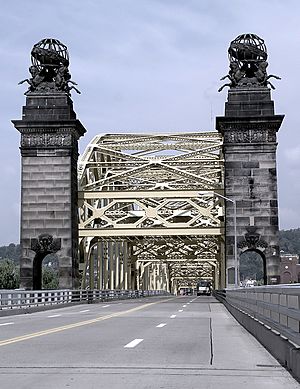David McCullough Bridge facts for kids
Quick facts for kids David McCullough Bridge |
|
|---|---|
 |
|
| Coordinates | 40°27′6″N 79°59′27″W / 40.45167°N 79.99083°W |
| Carries | 16th Street |
| Crosses | Allegheny River |
| Locale | Allegheny, Pennsylvania, United States |
| Other name(s) | Sixteenth Street Bridge |
| Maintained by | Allegheny County |
| NRHP # | 79002163 |
| Characteristics | |
| Total length | 1,996 m (6,549 ft) |
| Width | 41.3 m (135 ft) |
| Longest span | 437 feet (133 m) |
| Clearance below | 41.3 feet (12.6 m) |
| History | |
| Architect | Warren and Wetmore, architects |
| Designer | H.G. Balcom, engineer |
| Designated: | 2001 |
| NRHP reference No. | 79002163 |
| Added to NRHP | August 13, 1979 |
The David McCullough Bridge, also known as the 16th Street Bridge, is a cool steel bridge in Pittsburgh, Pennsylvania. It crosses the Allegheny River. This bridge is a special type called a through arch bridge.
Building the 16th Street Bridge
The 16th Street Bridge was built to replace an older bridge. That bridge was called the Mechanics Street Bridge. The new 16th Street Bridge was finished in 1922. It is about 1,900 feet (580 m) long and 40 feet (12 m) wide. In 1979, the bridge was added to the National Register of Historic Places. This means it is an important historical site. The 16th Street Bridge is very popular in Pittsburgh. It helps people easily get to the Strip District and the North Shore.
A Flood Scare
In 1936, Pittsburgh had a huge flood. It was called the St. Patrick's Day Flood. A few days after the flood, on March 20, 1936, some false reports spread. People thought the 16th Street Bridge had fallen down. They worried the floodwaters and debris had made it collapse. This made the Pittsburgh Police Chief close all city bridges. He was afraid other bridges might also collapse. Luckily, the reports were not true. The bridge was still standing!
Honoring David McCullough
On July 7, 2013, the bridge got a new name. It was named after David McCullough. He was a famous historian, author, and speaker from Pittsburgh. The Heinz History Center helped with the naming ceremony.
Images for kids




